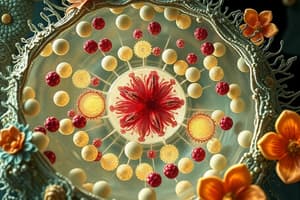Podcast
Questions and Answers
Which organelle is unique to plant cells and not found in animal cells?
Which organelle is unique to plant cells and not found in animal cells?
- Golgi apparatus
- Chloroplast (correct)
- Mitochondria
- Ribosomes
What structure is responsible for storing materials in an animal cell?
What structure is responsible for storing materials in an animal cell?
- Nucleus
- Vacuole (correct)
- Centrioles
- Cell wall
Which of the following organelles is involved in protein synthesis in both plant and animal cells?
Which of the following organelles is involved in protein synthesis in both plant and animal cells?
- Rough endoplasmic reticulum (correct)
- Lysosomes
- Centrosome
- Chloroplasts
What is the primary function of the cell wall in plant cells?
What is the primary function of the cell wall in plant cells?
Which organelle helps in detoxifying harmful substances in both plant and animal cells?
Which organelle helps in detoxifying harmful substances in both plant and animal cells?
Which characteristic is NOT associated with living things?
Which characteristic is NOT associated with living things?
Which reproduction method is a characteristic of some organisms?
Which reproduction method is a characteristic of some organisms?
What defines the lifespan of living things?
What defines the lifespan of living things?
Which of the following is a characteristic that distinguishes non-living things from living things?
Which of the following is a characteristic that distinguishes non-living things from living things?
What is true regarding the movement of living things?
What is true regarding the movement of living things?
What distinguishes autotrophic nutrition from heterotrophic nutrition?
What distinguishes autotrophic nutrition from heterotrophic nutrition?
Which of the following best defines 'growth' in living organisms?
Which of the following best defines 'growth' in living organisms?
What is a reason for organisms to exhibit movement?
What is a reason for organisms to exhibit movement?
Which statement about respiration is incorrect?
Which statement about respiration is incorrect?
Irritability in living organisms refers to their ability to:
Irritability in living organisms refers to their ability to:
Which statement accurately describes the relationship between predators and prey?
Which statement accurately describes the relationship between predators and prey?
Which of the following best defines the process of respiration in organisms?
Which of the following best defines the process of respiration in organisms?
How do autotrophs and heterotrophs mainly differ in their nutritional processes?
How do autotrophs and heterotrophs mainly differ in their nutritional processes?
What is primarily considered the irreversible increase in size, dry mass, or weight of an organism?
What is primarily considered the irreversible increase in size, dry mass, or weight of an organism?
What is the main purpose of excretion in organisms?
What is the main purpose of excretion in organisms?
Which of the following characteristics is NOT associated with living things?
Which of the following characteristics is NOT associated with living things?
What is the main purpose of reproduction in living organisms?
What is the main purpose of reproduction in living organisms?
Which of the following statements is true regarding non-living things?
Which of the following statements is true regarding non-living things?
Which organelle is primarily involved in photosynthesis?
Which organelle is primarily involved in photosynthesis?
What characteristic differentiates living things from non-living things?
What characteristic differentiates living things from non-living things?
Which of the following is a role of the Golgi apparatus in animal cells?
Which of the following is a role of the Golgi apparatus in animal cells?
Which of the following statements best describes adaptation?
Which of the following statements best describes adaptation?
Which of the following is NOT a function of living organisms?
Which of the following is NOT a function of living organisms?
Flashcards
What is movement?
What is movement?
The ability of an organism to move part or whole of its body from one place to another.
What is respiration?
What is respiration?
The breakdown of food substances to release energy, using oxygen (aerobic) or without oxygen (anaerobic).
What is nutrition?
What is nutrition?
The process of obtaining and using food for growth, maintenance, respiration, and reproduction.
How do plants obtain nutrition?
How do plants obtain nutrition?
Signup and view all the flashcards
What is irritability?
What is irritability?
Signup and view all the flashcards
Movement in organisms
Movement in organisms
Signup and view all the flashcards
Autotrophs
Autotrophs
Signup and view all the flashcards
Heterotrophs
Heterotrophs
Signup and view all the flashcards
Excretion in organisms
Excretion in organisms
Signup and view all the flashcards
Growth in organisms
Growth in organisms
Signup and view all the flashcards
Reproduction
Reproduction
Signup and view all the flashcards
Development
Development
Signup and view all the flashcards
Nutrition
Nutrition
Signup and view all the flashcards
Movement
Movement
Signup and view all the flashcards
Respiration
Respiration
Signup and view all the flashcards
Adaptation
Adaptation
Signup and view all the flashcards
Nucleolus
Nucleolus
Signup and view all the flashcards
Chloroplast
Chloroplast
Signup and view all the flashcards
Cell Wall
Cell Wall
Signup and view all the flashcards
Golgi Apparatus
Golgi Apparatus
Signup and view all the flashcards
Peroxisome
Peroxisome
Signup and view all the flashcards
Chromatin
Chromatin
Signup and view all the flashcards
What is the cell wall?
What is the cell wall?
Signup and view all the flashcards
What are chloroplasts?
What are chloroplasts?
Signup and view all the flashcards
What is the endoplasmic reticulum?
What is the endoplasmic reticulum?
Signup and view all the flashcards
What are amyloplasts?
What are amyloplasts?
Signup and view all the flashcards
What are lysosomes?
What are lysosomes?
Signup and view all the flashcards




